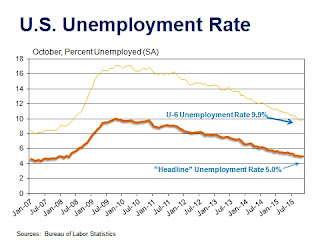The
U.S. Labor Market Report covering the national employment situation in November
showed a gain of 211,000 nonfarm jobs. The unemployment rate held steady at
5.0%. The average workweek edged down by 0.1 hour to 34.5 hours, but the
average hourly wage increased by four cents to $25.25. Over the year, average
hourly earnings were up by 2.3%.
The employer payroll
survey reported that total nonfarm employment in the United States increased by
211,000 jobs in November. The private sector contributed 197,000 jobs to the
November increase, while the public sector added 14,000 jobs with gains at all
three levels of government: federal, state and local. Employment growth was
broad based with nearly every major industry sector adding jobs over the month.
The exceptions were manufacturing, hurt by weak export growth and the strong
dollar, mining and logging (primarily in the energy extraction sector), and
information. There was also a positive
net revision to the September and October figures of 35,000 jobs. Over the past
three months, job gains have averaged 218,000 per month. The 2015 year-to-date
average monthly gain was 220,000 jobs, somewhat below the 253,000 figure recorded
for the same period in 2014.
On a year-to-year basis,
U.S. employment expanded by 2.637 million jobs, an increase of 1.9%. In
year-to-year terms (YTY), mining and logging was the only major industry to
record a decline with a loss of 123,000 jobs (-13.5%). The largest YTY gain
occurred in health care and social assistance with 580,800 jobs added over the
year, an increase of 3.2%. Leisure and hospitality added 438,000 jobs (up
2.9%). Professional and technical services also posted a strong gain (298,400
jobs, 3.5%), as did retail trade (284,200 jobs, 1.8%).
Turning to the household
survey, in November, the unemployment rate held steady over the month at 5.0%
and was down from the year-ago rate of 5.8%. The labor force participation rate
increased slightly over the month, rising to 62.5% and bringing 273,000 workers
into the workforce. Last year at this time, it was 62.9%.
The more comprehensive U-6
unemployment rate was 9.9%, well below the 20-year average for this indicator
of 10.7%. The U-6 unemployment rate counts part-time workers who would prefer
full-time work and individuals who would like to work but have given up looking
for a job.
Other indicators also
demonstrate labor market slack is diminishing. The share of workers who have
been jobless for 27 weeks or more dropped to 25.7% of all unemployed persons,
down from the year ago rate of 31.0%. The average rate going back to 1990 is
25%. Over the past 12 months, the number of long-term unemployed persons has
fallen by 782,000. The median duration of unemployment is also on the decline,
falling from 12.8 weeks in November 2014 to 10.9 weeks last month.
Summary: The
labor markets delivered another strong performance in November. With
manufacturing jobs edging lower last month, and mining employment falling for
the 11th consecutive month, the services sector delivered 163,000 jobs, while
the rebound in residential and nonresidential construction pushed construction employment
higher by 46,000 jobs. Overall job growth has kept the unemployment rate steady
at its lowest rate in seven years, and wage growth continues to outpace
inflation.


No comments:
Post a Comment